
Vol. 1, No. 4 Published by India China Division, Air Transport Command Feb. 8, 1945
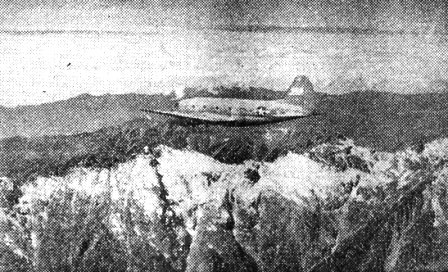 This China-bound ICD transport - cresting the tops of the snow-covered Himalaya mountains with a load of war materials
for Allied combat forces fighting the Japs - symbolizes ICD's tremendous achievement in airlifting more than 44,000 tons
over the Hump during January - the greatest tonnage lift in history !
This China-bound ICD transport - cresting the tops of the snow-covered Himalaya mountains with a load of war materials
for Allied combat forces fighting the Japs - symbolizes ICD's tremendous achievement in airlifting more than 44,000 tons
over the Hump during January - the greatest tonnage lift in history !
|
Weekly, Daily, Other Records Eclipsed Again
Total Cargo Touches Ton a Minute In Month
New daily and weekly record air lifts to China sent the January ICD total soaring to 44,000 tons - more than three times the amount carried over the Hump in the corresponding 1944 month, and twice the aggregate for July.
In one January week, ICD transports delivered 12,000 tons of cargo to China - almost as much as hauled in December 1943, for which the division won the Presidential Unit Citation. The 38 percent increase in January over December - from 31.935 to 44,000 tons - exceeded the citation month figure. The record week's aggregate beat the tonnage carried in any of the first 12 months of operation and exceeded the total for the first six months.
Ton a Minute
During January, records set last November fell time after time. When the month ended, the scoreboard revealed a daily total half again as great as the tonnage moved in the first entire month's operation - December, 1942.
At operational peaks in January, material was flown to the 14th Air Force, SOS, XX Bomber Command and the Chinese at the rate of more than a ton a minute. Aircraft crossed the Hump eastward every two and a half minutes 24 hours a day.
Long Haul Increase
Ton miles flown during the month sky-rocketed 362 percent over the same month of 1944, reflecting the boost in long-range haul. In January, 1943, ICD flew 1,133,465 ton miles; in January, 1944, 8,871,017; in January, 1945, 41,000,000.
Ton miles flown to China over the Hump showed comparable increases. They rose from 569,187 in January, 1943; to 6,910,684 in January, 1944; to 31,000,000 in January, 1945.
These achievements in supplying the Allies in China were made possible through the cooperation of many other military agencies: ASC which provided maintenance assistance; SOS which distributed a great portion of the China cargo; the 14th and the 10th Air Forces which protected ICD routes, and both theaters and the Chinese government.
Three Daily Round Trips
Many other factors contributed to the staggering tonnage increases; more Hump routes and navigational aids; improved loading, unloading and servicing techniques resulting in minimum grounding of aircraft at turnaround facilities, improved communications, improved weather analysis, and full-scale training. With decreased turn-around time, it was not uncommon for the same ICD transport to make three round trips from India to China in a single day.
Success in its primary mission - transporting military supplies to China - has been achieved by ICD while accomplishing other missions of great scope.
Other Missions
Short notice movement of thousands of Chinese troops, delivery of thousands of tons of munitions, and the rushing of medical supplies to Chinese Communist areas have highlighted ICD operations within the last 90 days.
In addition, ICD has actively participated in emergency evacuation of certain forward airbases, snatching personnel, equipment and munitions from the Japs' hands time and again. Still another activity is evacuation of medical casualties from forward areas.
Added to its standard missions are flights into North China, round-the-world flights in which ICD provides transport 50 percent of the way, and special trail-blazing inter-theater flights.
|
First ATC Ticket From China to U.S. Sold to Civilian HQ., CHINA WING, KUNMING - The old thumb still may be a super-inducer of transportation back in the States, but it won't work anymore as a ride-getter on an ATC plane bound for Uncle Sugar. Words to that effect were uttered the other day by Capt. Lawrence D. Schwartz, Philadelphia, Pa., director of priorities and traffic for ICD here, as he sold the first ticket for ATC transportation homeward to a civilian. The purchaser was J. Harry Fernan, former business manager of the FEA's China mission headquarters at Chungking. Price of the one-way ticket wasn't revealed, but it was in accordance with ATC's "controlled prices" established recently when the War Department announced civilian passengers whose travel was connected with the war effort could pay as they fly with ATC, on any of its world-girdling airways. Capt. Schwartz put it this way: "There will be no more hitch-hiking on ATC aircraft. From now on, it's cash on the line for U.S. civilians whose travel isn't officially authorized by the War or Navy Departments or the Office of Strategic Services, and for foreign nationals whose fare is not chargeable to lend-lease." |
Meals, Billets, Other Services
Furnished by Division to Riders
On Network of Military Airlines
Figures on Safe Air Travel Believed Unequalled in World
The ICD, whose aerial network stretches like a vast spider web across three countries, has assumed its place among operators of the greatest airlines in the world, carrying something like a half million passengers more than 100,000,000 miles a year.
Although passenger service is but one of ICD's several missions, the division flies airways totaling more than 18,000 miles in India, Burma and China.
P & T Job
Moving ever-increasing tonnage over the Hump, flying combat troops in support of tactical operations, and evacuating sick and wounded from front lines are other important phases of the ICD mission, but the press of these important operations doesn't prevent furnishing passenger service as near Stateside as possible under war conditions.
This is the job primarily of the Priorities and Traffic section. In India passengers ride in "plush-lined" C-47's, with reclining seats, curtains and the services of trained flight traffic clerks, who furnish reading material, serve coffee and answer questions.
All Pitch In
Many people aside from the crews are responsible for the operations of an airline of the magnitude of ICD's in a foreign land.
Mechanics, maintenance men, servicing experts, familiar with the operational picture, are complemented by traffic clerks, dispatchers, aircraft load experts, priority clerks, passenger officers and a host of others in main passenger terminals.
Their job is to check the passenger's priority, issue a ticket, route him to his destination, assign him to the first transport with available space, check his weight, including baggage, load it on the aircraft, and speed him on his way as rapidly as possible.
Not all passengers travel straight through without overnight stops. When not flying these stop-over passengers become the charges of ICD's transient service operated by the supply and service section.
This organization is responsible for messing, billeting and transportation of its overnight guests - for a day or three days as the case may be. A good bed, a good meal and prompt transportation to mess halls, barracks and the flight line or takeoff next day is a far cry from the old days of waiting endless hours in dreary offices up and down the line.
A hundred thousand billets a month and a quarter of a million meals, transient service takes in its stride. It houses GI's, generals, actors, Red Cross Girls and diplomats, looks after their lost baggage through a central lost
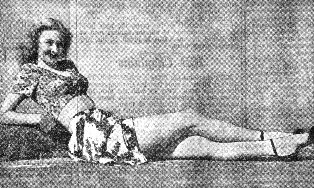 There's nothing like home cooking, and this happens to be some home made cheesecake dreamed up by a soldier photographer.
The subject is Annette MacQuarrie, of USO troupe 269 which has played the basha circuit from one side of the Hump to the
other during the past half year.
There's nothing like home cooking, and this happens to be some home made cheesecake dreamed up by a soldier photographer.
The subject is Annette MacQuarrie, of USO troupe 269 which has played the basha circuit from one side of the Hump to the
other during the past half year.
|
Distinguished Passengers
A typical ICD airliner on its regular run across India may have on board a general, a famous war correspondent and a Hollywood movie star - as well as its load of military personnel of lesser fame.
Flight clerks didn't just come by their jobs. Each is a picked enlisted man graduated from a special army school. The division operates a Flight Clerk school at the 1303rd BU. They know what to do and have charge of their passengers comfort while in flight.
The airline service is but a part of ICD's priority and traffic section's never-ending work. Added to the passenger transports which also handle mail are the scores of heavily loaded cargo transports which stream across the three countries.
Big Business
From the viewpoint of passenger service alone, ICD is in business in a big way. Its achievement, announced in last week's EXPRESS, of flying 142,443 passengers some 60,654,000 passenger miles without a fatality or a major injury in five months is indicative of its success.
Those figures, believed unequalled by any military transportation system, reveal not only the volume of urgent military business the division's airline handles, but the progress obtained in the safe, comfortable and swift transport of military personnel over a sizeable portion of the world.
Thanx, Says Arnold For Still Another Hump Cargo Record
The personal commendation of General H. H. Arnold to all ICD personnel for their tremendous January tonnage record has been received by Brig. Gen. William H. Tunner through Maj. Gen. Harold L. George, commanding general, ATC.
General Arnold pointed out that ICD's new tonnage record of more than 44,000 tons a month was achieved despite adverse weather conditions early in January, and reflected high morale and efficient leadership of an organization imbued with the finest traditions of the Air Forces.
General George joined General Arnold in commending ICD for "its phenomenal achievement" and expressed his appreciation to all India-China Division personnel for their efforts in establishing the all-time record.
Engineering Maintenance Feat Recorded at 1304th
1304TH BU, INDIA - At about 0800 a few days ago the engineering section at this base was told that 12 C-47's were being transferred to China and would have to be readied for departure within 24 hours.
With the base already crowded by increasing traffic, the engineering section was plenty busy and the addition of the special project was a large order.
Nine of the ships were due for 50-hour inspections; two needed 25-hour once-overs and another required a 100-hour acceptance check.
Maintenance crews immediately went to work on eight of the C-47's. Four were still out on cross country hops. Grease monkeys swarmed all over the parking ramps. Above average transport traffic jammed three and four ships into one small revetment. A C-46 had to go out the next day and the job of installing a wing, without regular equipment, was handed the busy mechanics.
Through the day and into the night Maj. Jay Grimm's engineering section buzzed with activity. Under the direction of his three assistants, Lts. Herman Berger, Richard M. Johnson and Robert E. Davis, new shifts came on and others retired for much needed rest. Line chief M/Sgt. Walter F. Collins and his assistants, T/Sgts. James W. Hughes and Gerald F. O'Donnell, kept regular traffic flowing as they assigned and transferred crews.
Without A Mishap
At 4 a.m. the next day, the ships, inspected, gassed-up, and oxygen equipped, stood lined up on the taxi strip waiting for takeoff time. The job had been done without working a single maintenance crew overtime. Only in the office where the transfer forms had to be made out had the men worked longer hours. Although the field was packed with planes, not one mishap or accident was encountered.
'Roll Out The Barrels' Is Theme Of Fourth Mobile Transport
1340TH BU, CHINA - "Roll out the Barrels," theme song of the 4th Mobile Transport squadron at this base, signified the spirit with which it has just broken an all time division record for flying time per assigned aircraft over a ten-day period.
needless to say, the commanding officer of the 4th, Captain Fletcher A. Hatch, Jr., is justly proud of his men.
Flying night and day into the mountain regions of Northern China, the Fourth's pilots, crew members and other personnel established the remarkable flying time of 10.8 hours per plane from the 10th to the 20th of January. Crew chiefs rode their planes on all trips and then worked late after landing to keep them in good mechanical shape.
Not satisfied with the usual rapid means of unloading, crew members carried a rubber tire in their craft and immediately upon landing with a load of gas they opened the door, tossed the tire on the ground, unlashed the barrels, and rolled them onto the tire, before surprised ground unloaders could reach the ship.
The squadron also points with pride to the preceding ten day record of 8.4 hours per assigned aircraft, which topped all other China stations in the ICD. Statistical control figures show that the 4th leads the China Wing through the 24th of the month with an average of 9.4 hours per assigned aircraft.
The enviable record has not gone unnoticed by division HQ, which has just forwarded a commendation to the commanding officer of the 1340th, Major Wayne M. Gundry, Flint, Mich., for operations during the first 15 days of January in which an average of 9.47 was maintained, and on one special day a peak of 15 hours and 58 minutes was reached.
Another commendation from HQ of the China Wing stated: "You and your command, both Base and Mobile squadron, are to be commended on the outstanding record. The results obtained indicate excellent leadership, a willingness to show improvement and an attempt to continually improve the operation and utilization of your aircraft."
The squadron recently received an SOS from one of the northern bases, asking for a five-day haul which would require a minimum average of eight hours per day for each aircraft that the organization possessed.
This staggering quota, however, did not stagger the 4th, and they began at once to meet the demand. They flew into the frigid mountain regions where every let-down to the field had to be accomplished on instruments because of prevailing fog and storms this time of year.
The job had to be done and they did it ... and more. The required tonnage was topped by approximately 10%, and the average flying time reached the 13.5 hours mark per squadron craft, or five hours and 30 minutes over the required average. Turnaround time for this five day mission was done at the remarkable average of 15 minutes from the time each ship hit the ground and stopped rolling until it had taken off for the long flight back.
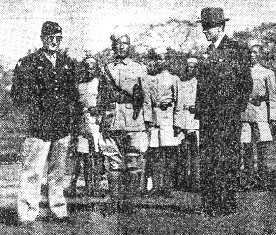 1337th BU, Assam - Sir Andrew Clow, governor of Assam, right, photographed during a recent tour of the 1337th with
Lt. Col. George S. Cassady, Kansas City, commanding officer of the base. In the background are members of the Assamese
police guard.
1337th BU, Assam - Sir Andrew Clow, governor of Assam, right, photographed during a recent tour of the 1337th with
Lt. Col. George S. Cassady, Kansas City, commanding officer of the base. In the background are members of the Assamese
police guard.
|
In Transportation of Sick, Wounded
MAES Whisks Its Patients From Forward Areas In Comfort
P & T Streamlines Trips, Expedites Service All the Way
HQ., CALCUTTA - He may have been a Mars infantryman hit at Bhamo, or perhaps a Mustang pilot who ran into a dose of flak in Yunnan, or maybe a crew chief from an ICD Hump flight base who walked out of the jungle after a parachute landing. All such men, and thousands of them, know the growing importance of the Medical Air Evacuation squadron attached to ICD.
As he lies between crisp, clean sheets in a hospital over on the sunny side of the world, he might well recall the amazing speed and comfort with which he was transported from a forward area into the zone of the interior. It is no illusion that two short weeks ago he was fighting the battle of Burma or flying in combat or helping to wheel cargo over the Hump. Hundreds like him, every day, are being taken to hospitals where they can receive proper medical attention.
Typical Evacuees
To hospitals near here, one night this week, came a plane load of typical beneficiaries of the gigantic evacuation plan. Cpl. Jack R. Herring, Mansfield, Ohio, and T/3 Glen E. Brough, Grand Rapids, Mich., MAES men attached to an ICD base, met the ship, as they do all MAES craft reaching that field.
Piloting the mercy craft were 1st Lt. C. V. Wakeman and 2nd Lt. C. B. Boyd. Radio operator and engineer were Pfc. B. Somel and Pvt. N. S. Kolikohn. Lt. A. Newland, of San Francisco, was the attractive nurse. When the patients were taken over by Brough and Herring at the airport, her job was done - but back she will go, as soon as feasible, for another assignment.
The sixth member of the party was a surgical technician, Cpl. Robert R. Reedy, of Macomb, Ill. He too was scheduled to head back to forward zones at once.
"Met Truck"
T/Sgt. Frank Kemper, New York City, a fighter control squadron radio op, had turned over a jeep and smashed his arm. Rotation-due S/Sgt. Wallace Harper, radio man aboard a bomber, ran into some flak in a January mission and got it below the knee, which is broken. (Two Jap ships were sunk on that mission.)
S/Sgt. Ray Steffen, portable surgical hospital GI, "met up with a truck" on the Ledo Road, and his leg was crushed.
The remaining five of the eight aboard the hospital ship declined to state their names. All were ambulatory.
MAES was built with infinite care and planning. In the beginning it was realized that successful evacuation had a two-fold purpose. First, rapid transport must be provided, with minimum delays, and second, maximum patient comfort must be assured. All units of ICD were called on for assistance, but the heaviest share of the load was borne by priorities and traffic, because of the nature of the job to be done.
P & T worked hand in hand with MAES. First of all, travel arrangements were streamlined. Then hospital planes were provided, with litters for bed-patients and some additional litters so that ambulatory cases might rest on long flights. Hospital planes were also equipped with heaters and blankets. Coffee and sandwiches were placed aboard for in-flight lunches, and nourishing meals made ready at stopover points en route.
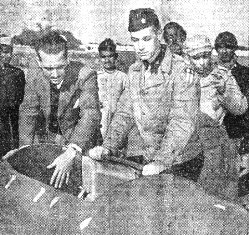 Lt. Col. Ledbetter, CO of the 1307th, has a reputation for being where things are happening. Here he looks over a new
Link trainer with Arthur Hanson, supervisor of civilian personnel.
Lt. Col. Ledbetter, CO of the 1307th, has a reputation for being where things are happening. Here he looks over a new
Link trainer with Arthur Hanson, supervisor of civilian personnel.
|
Base Commander with ATC
From Ferry Command Days
Swing Through Various Sections of United States
Was Followed by Further Service In Africa and in England
1307th BU, NEW DELHI - Lt. Col. Joel Y. Ledbetter, CO at 1307th, came into the ATC in the days of its inception when it was still known as the Ferry Command.
With a record of military service dating to 1935 when he joined the National Guard of Arkansas, Col. Ledbetter was called to active duty in Sept., 1940. He was at that time a member of the 154th Observation squadron and had held a private flying license since 1938.
Assigned to Romulus
A year after being called into active service he was transferred to the Ferry Command, which then consisted of some 30 officers with headquarters in a small basement room in Washington, D.C.
His assignment in those early days of organized air ferrying was at the ATC base in Romulus, Mich. Next he moved to Miami, Fla., and was control officer there at the time the Ferry Command became the Ferrying Division under the newly organized Air Transport Command.
From Florida Col. Ledbetter went to Wilmington, Del., where for nine months he was foreign operations officer of the ATC base there. A promotion to squadron commander was quickly followed by further advancement to the post of deputy commander of the 2nd Ferrying group at the Delaware base. Later, transferred to Presque Isle, Maine, he served as deputy commander of the four-engine transport group which operated C-54's over the North Atlantic.
Executive Officer
Completing his swing of the U.S., he went to Long Beach, Calif., where he became executive officer of the western sector of the Ferrying Division. Although he has been to Africa and England on ferrying missions, his present assignment brought him to India for the first time.
Col. Ledbetter is married and has a six-year-old daughter and a son who is four. His family lives at Little Rock, Ark., where he was formerly connected with the Williams and Rosen Insurance Company.
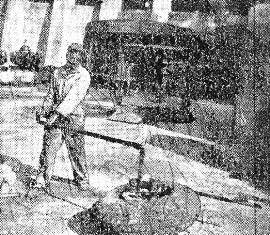 Pfc. Roosevelt Moore demonstrates the apparatus he concocted to remove a tire from the wheel. Operated easily
by one man, its chief benefit lies in preventing bruises to the tire bead, the case when irons were used.
Pfc. Roosevelt Moore demonstrates the apparatus he concocted to remove a tire from the wheel. Operated easily
by one man, its chief benefit lies in preventing bruises to the tire bead, the case when irons were used.
|
Moore Invents Twin Gadgets For Tire Use
Bead-roller is Result of Four Years' Study And Work
1327th BU, ASSAM - After thinking about it for four years, Pfc. Roosevelt Moore of this base has made, just at the time the pressure to conserve tires is on, a pair of devices calculated not only save time but also rubber.
Working in the tire change shop, Pfc. Moore finally developed a tire bead-roller, the need of which he had realized for years as a chauffer in Orange, New Jersey.
Tire Changes
Tires change on the C-87 or B-24 had especially dictated the need for such a device. The nose wheel of a C-87 has a drop-center rim which makes tire removal or installation difficult. Often beads were damaged when tires were removed with sharp tools and crude methods. The new invention has completely done away with tire irons and allows one man to accomplish easily what formerly required three or four brawny men to do.
Realizing the value of Moore's brainchild, the division maintenance section plans to have blueprints made of the bead-roller when the drawings are sent in. These blueprints will go to the various bases with the suggestion that the bead-roller be constructed wherever practicable.
Moore's second invention, a machine to remove tubes, succeeds similarly in saving manpower and increasing the life of the tubes by preventing "pinching." Removing the double seal or lifeguard type of tube from a casing had formerly been a much hated job. Of extremely heavy construction, the tube refused to separate from the tire. Using Moore's method only one man is required and the tube is eased from the casing with no possibility of damaging it.
The division rubber coordinators have seen both the devices work and have high praise for their efficiency and the ultimate saving of tires and tubes if accepted throughout the division.
Elephants Figure in New Aircraft Loading Wrinkle
1328th BU, ASSAM - A loading experiment conducted at this base brings together Elmer the Elephant, the workhorse of the jungle, and a C-46 Commando, ICD workhorse of the air.
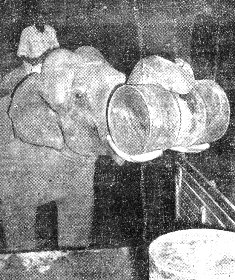 In this photo Elmer does it the easy way as he grapples a heavy gasoline drum with his curved-to-order tusks.
In this photo Elmer does it the easy way as he grapples a heavy gasoline drum with his curved-to-order tusks.
|
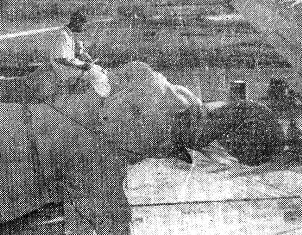 Here goes Elmer for a quick trip from the parked truck to the aircraft. On his back rides the mahout who assists
the pachyderm when he is found lacking in the required "know-how."
Here goes Elmer for a quick trip from the parked truck to the aircraft. On his back rides the mahout who assists
the pachyderm when he is found lacking in the required "know-how."
|
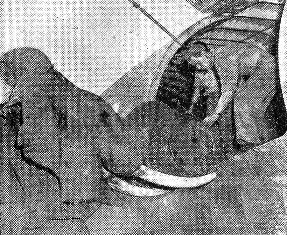 "Oopsadaisy, Elmer," says the GI in the plane, as ICD's newest aircraft loader gently deposits the drum in the open
cabin door. It takes a half a dozen men to do the same job "the hard way."
"Oopsadaisy, Elmer," says the GI in the plane, as ICD's newest aircraft loader gently deposits the drum in the open
cabin door. It takes a half a dozen men to do the same job "the hard way."
|

HUMP EXPRESS is in receipt of communications from many points in ICD which say good things about the paper. It is impractical to publish all the communications received or to express appreciation personally to everyone who has seen fit to speak well of the newspaper's maiden efforts. So - the editorial staff takes this means of saying: "Thanks." As General Tunner pointed out - when the forty-four thousandth ton was air lifted over the Hump on February 31 - "Teamwork Did It." The air crew driving a huge cargo-packed transport over the Himalaya mountains to China is part of a tremendous team of people working 'round the clock from Karachi to Calcutta to Kunming and pulling together to increase the efficiency of operations and tonnage lift. No one man, no few men, but thousands of men, symbolized by the sweating, hard working American GI, in offices, warehouses, and repair shops, on parking strips, loading ramps, and supply dumps; behind the wheels of trucks and in airplanes, are responsible for the magnificent achievement reflected in January's tonnage. It's an old theme, but mighty true - that teamwork gets the job done, whatever it may be. The football star doesn't make touchdowns unless his interference takes tacklers out of the way. Nor does the ICD pilot deliver tonnage over the Hump unless many other people co-operate with him. So - bear in mind that it's everybody pulling together that gets war materials to China. And the harder we pull together the more tonnage we send over. |
|
Today, when the neophyte steps off the plane into a completely strange land, the shock is softened no end by the rapidity with which he is given help by ICD. General, statesman, officer or plain GI, he is made aware at once that everything he needs will be done for him at Karachi airbase. And he soon learns it's done with a grin by the guy who billets him, handles his luggage and tells him the rules. The grin is the thing that helps the most, for the traveler has heard wild tales of this far oriental scene. All at once, the traveler sees what Bob Hope meant when he title a recent book, "I Never Left Home." Karachi airbase is a little America, with America's traditional helpfulness and good will. It's here the traveler gets his first impression of ICD. Subsequent experience may heighten or slacken the level he sets, but every passenger makes his mental mark about the entire ICD operation right there. That's why HUMP EXPRESS says, "Congratulations, Karachi." The well-drilled, well-dressed, hard-working men at that base give the traveler a real taste of what ICD's service means. The air of efficiency that pervades the atmosphere at India's aerial gateway sets a mark that other stations can shoot at. Not that Karachi's perfect, for men around the base will tell you where this, that and the other can be improved - as at any base. But - from the CO on down, they're doing something about it. Right now, for example, new transient billets are going up on the base, to save the trip the traveler must make today before he gets to his bunk; and other changes are planned, as Karachi keeps forging ahead. Karachi is the India-China Division's "front door." Through it go the great, the near great and, most important of all, the fighting men of the United Nations. ICD is proud of the way Karachi greets them. |

Dear Editor:
All of us here think the HUMP EXPRESS is a fine paper and is filling a need in the ICD. There is one thing, however, that rubs our group of radio ops the wrong way. In your articles concerning the guys who are going over the rock pile 24 hours a day, day after day, the pilots seem to be the only ones who can be found in our transport aircraft. No one sweats out a storm or an engine failure, etc., any more than we. We don't want any less recognition of our pilots - but we would appreciate a nod once in a while in our direction. We must be doing a job or we wouldn't be there.
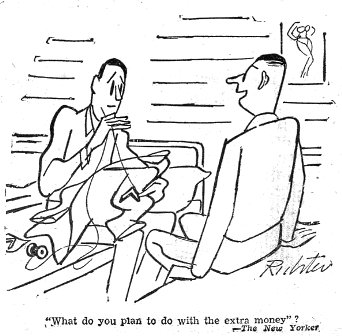
|
Ed.- To all radio ops, a pat on the back for their fine work. HUMP EXPRESS is not forgetful of the tremendous job they are doing.
Dear Editor:
Can you tell us why this is an all India paper? Why don't we see some news about the China bases here in the EXPRESS? We're in the ICD too, and are doing just as important a job as any of the other bases. So why haven't we been recognized too? - JBM
Ed.- We are especially anxious to have all possible news from the China bases because the military operations there are one of the main reasons for our being here. However, we need support from the bases to send in more stories and pictures so that we can get the material to publish.
Dear Editor:
Congratulations on the first issue of HUMP EXPRESS. Papers are being received enthusiastically everywhere in Assam. You and your staff are to be commended for getting off to a good start. - Col. William S. Barksdale, CO, 1330th BU
Ed.- we're proud, sir.

|
Kemi-Nodi Sojourners Learn About Jungle Life While They Have Fun
Twenty minutes by air from one of ICD's biggest Assam bases, a transport plane lands on a former fighter strip. Its passengers are assigned to temporary "duty" at Kemi-Nodi Lodge. For a week if they are GI's, for four days if officers, they will combine business and pleasure, with pleasure predominating but with the most serious work being accomplished too.
Kemi-Nodi Lodge is one of several camps in which ICD has been developing the theory that jungle knowledge is best acquired by living in the jungle - making the acquaintance of jungle people, becoming familiar with various types of jungle terrain, and subsisting partly on the fare which can be found in the jungle by those who know how.
The importance of this knowledge, of course, needs no explanation to men who fly the Hump. Hump travel is growing less dangerous every day, but each man regularly assigned to it must face the possibility that some day he may have to bail out over jungle, and a little jungle lore may spell the difference between life and death to him.
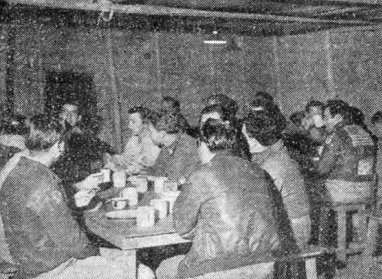 A corner of Kemi-Nodi mess hall. The taste of C-rations and the sight of spam are forgotten, for the lodge mess is
altogether out of this world, or at least this continent, a prominent feature being venison steak.
A corner of Kemi-Nodi mess hall. The taste of C-rations and the sight of spam are forgotten, for the lodge mess is
altogether out of this world, or at least this continent, a prominent feature being venison steak.
|
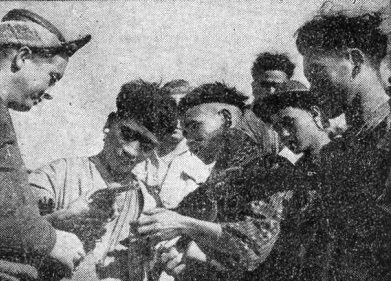 Jungle tribesmen devote earnest attention to a U.S. service revolver, as a GI briefs them. They are perhaps no
more interested in the revolver, though, than the visitor may be in their punctured earlobes and in hats like the one
at right center, which are woven of reeds and tightly compressed. Most GI's bring back souvenirs of some kind.
Jungle tribesmen devote earnest attention to a U.S. service revolver, as a GI briefs them. They are perhaps no
more interested in the revolver, though, than the visitor may be in their punctured earlobes and in hats like the one
at right center, which are woven of reeds and tightly compressed. Most GI's bring back souvenirs of some kind.
|
"Lazy River"
Founded in 1943 by the late Col. Harry N. Renshaw, later killed in flight, Kemi-Nodi is located in the foothills of the Himalayas. Kemi-Nodi means "lazy river," and the tranquil stream bears out the name. There is a village two miles away, consisting merely of a post office and one bazaar. Further north is a larger village. But in and around the camp is some of the wildest jungle to be found in India.
Four expeditions from the camp are scheduled for the visitor assigned to Kemi-Nodi's pleasant regiment. A trip to "town" in which he talks with tribesmen (usually finding it surprisingly easy to make himself understood, after a little practice) puts him at ease with people whose ways of thought are as different from his own as anyone's on earth, but who are really very human people after all.
A hike through the jungle insures him against meeting its towering grasses and impenetrable undergrowth for the first time as a parachutist. Third, a jaunt up the quiet reaches of the "lazy river" in a rubber life raft, unguided, acquaints him with the feeling of isolation which can be one of the jungle's terrors for the uninitiated. The fourth trip is baksheesh - a visit to a lumber camp, planned as a sightseeing junket but not uninstructive either.
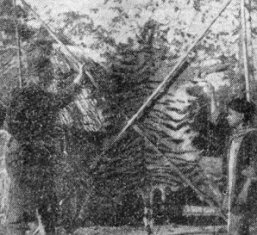 Big game like this isn't brought in every day, but it does happen, and the possibility is always an excitement.
Big game like this isn't brought in every day, but it does happen, and the possibility is always an excitement.
|
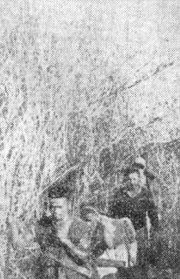 A party is led by guides through towering grass, which looks impenetrable to the newcomer but melts away under
the razor-keen knives of the guides.
A party is led by guides through towering grass, which looks impenetrable to the newcomer but melts away under
the razor-keen knives of the guides.
|
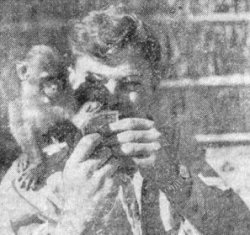 A Kemi-Nodi idler-and-student gets kibitzed-on by Tojo, lodge mascot. Tojo, a bonafide character, just walked in out
of the jungle one day and stayed. He salutes GI's as well as officers, but otherwise his conduct is correct - and
charming.
A Kemi-Nodi idler-and-student gets kibitzed-on by Tojo, lodge mascot. Tojo, a bonafide character, just walked in out
of the jungle one day and stayed. He salutes GI's as well as officers, but otherwise his conduct is correct - and
charming.
|
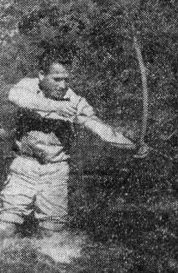 One of the enlisted men who act as instructors at the lodge, all expert woodsmen, is a great hand at bumping off
fish with a bow and arrow.
One of the enlisted men who act as instructors at the lodge, all expert woodsmen, is a great hand at bumping off
fish with a bow and arrow.
|
"What Was That Noise?"
The rest of the guest's time is his own, and his jungle indoctrination usually goes right on through his free hours. If, as many do, he goes hunting in the evening (weapons are issued) he may experience in a relatively painless manner the coming of darkness and the beginnings of the million noises of the jungle night.
He will undoubtedly find himself wondering what that noise was, no matter how many pamphlets he may have read which have told him a man is lucky to see one tiger in a month in any jungle! Then after a while his apprehension will pass away, and if he ever has to parachute, he will land with one less strike on him.
All this is a great experience but for those who like their fun a little less rugged now and then, Kemi-Nodi offers fishing, motorboating, volleyball, swimming, rowing, horseshoes, croquet, badminton, tennis, ping-pong, books - and just plain loafin'. All in all, it's about the easiest way a man ever got a specialized education in a subject which some day may save his life.
Col. renshaw, it is said, made an initial payment of Rs. 1,000 from his own pocket in establishing Kemi-Nodi. No more fitting monument could have been devised for Renshaw, who was famed throughout the valley for his devotion to his men, than the project of combined rest and jungle orientation which is affording so many of them a pleasant vacation and a piece of solid life insurance.
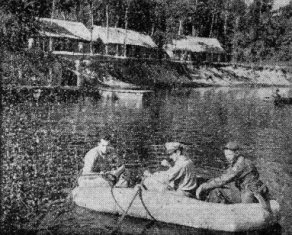 The Kemi-Nodi waterfront; a life-raft party in the foreground. If you prefer to relax more actively on the river,
an outboard job is available, and if you want to speed up your fish-catch, there are nets.
The Kemi-Nodi waterfront; a life-raft party in the foreground. If you prefer to relax more actively on the river,
an outboard job is available, and if you want to speed up your fish-catch, there are nets.
|
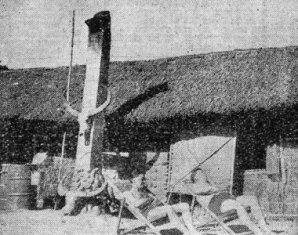 A pair of refugees from the Hump are taking off from indoctrination and doing some heavy basking. Few forget to allow
a few hours for this form of sport, even in the presence of more exciting
pastimes. A week at Kemi-Nodi never fails to
pass too quickly, and promptly on the seventh day comes the shuttle plane which returns the guest to his base in twenty
minutes.
A pair of refugees from the Hump are taking off from indoctrination and doing some heavy basking. Few forget to allow
a few hours for this form of sport, even in the presence of more exciting
pastimes. A week at Kemi-Nodi never fails to
pass too quickly, and promptly on the seventh day comes the shuttle plane which returns the guest to his base in twenty
minutes.
|
1,459 Awards Made in ICD During Month
HQ., CALCUTTA - Reflecting the enormously stepped-up activities of the division, 1,459 military awards were made to ICD personnel during January.
Though less than the total of November, 1944, the figure represents honors to more individuals then were received in any previous month, November's figures having included more recipients of double awards, and also a few who got as many as four awards, owing to backlogs existing at that time.
For the first time, so far as records of the personnel section indicate, more GI's than officers received awards.
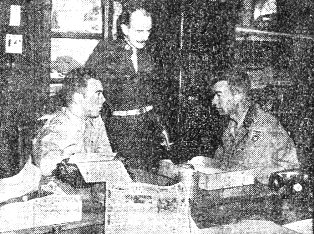 Once a bailout, twice a last minute evacuee, T/Sgt. Samuel D. Smith - who has spent the last six months doing
on-the-spot sketches of ICD activities on the tactical fronts in China - tells his story to 1st Lt. Horace H. Gaffney,
ICD bas public relations officer at Karachi, who interviewed the sergeant at headquarters while Capt. James P. Scott,
artist attached to graphic information section, HQ., listens in.
Once a bailout, twice a last minute evacuee, T/Sgt. Samuel D. Smith - who has spent the last six months doing
on-the-spot sketches of ICD activities on the tactical fronts in China - tells his story to 1st Lt. Horace H. Gaffney,
ICD bas public relations officer at Karachi, who interviewed the sergeant at headquarters while Capt. James P. Scott,
artist attached to graphic information section, HQ., listens in.
|
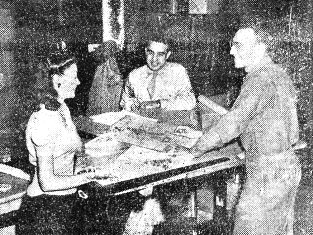 Kin Platt, ICD's own cartoonist, whose work in the EXPRESS has brought chuckles from throughout the division, pauses
at his sketchboard to talk over next week's idea with Miss Daphne Scott, civilian employee from headquarters' personnel
section. T/Sgt. Phil Stein, special service NCO, seems more interested in Miss Scott than artist Platt's "Idea."
(Blame him?)
Kin Platt, ICD's own cartoonist, whose work in the EXPRESS has brought chuckles from throughout the division, pauses
at his sketchboard to talk over next week's idea with Miss Daphne Scott, civilian employee from headquarters' personnel
section. T/Sgt. Phil Stein, special service NCO, seems more interested in Miss Scott than artist Platt's "Idea."
(Blame him?)
|
Platt, Express Cartoonist, Really Has Got Something
Kin Platt, cartoonist and private, who from now on will draw a cartoon a week for HUMP EXPRESS, can look back 15 years at a hectic and myopic past and as the hazy panorama unfolds, assuming shape, color and monotony, mutter "Did this happen to me?"
Besides having created SUPERMOUSE, the mighty and lovable rodent feared by all self-respecting house cats, and drawn the Pepsi-Cola cops, Pepsi and Pete, a number of years, Platt is married and the stepfather of Smokey Platt,
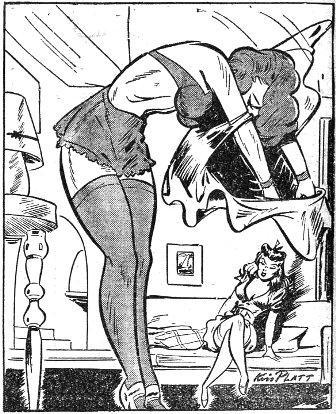 "For all the money he has, he doesn't dance badly."
"For all the money he has, he doesn't dance badly."
|
Gagman for Greats
The cartoonist, now assigned to division special service, has listed at various times and degrees, sometimes badly, between cartooning and writing. In radio, he was comedy writer for Jack Benny, Burns and Allen, Stoopnagle and Budd, Ken Murray and Edgar Bergen. He wrote the first show starring a new Hollywood unknown, Mary martin. Since then, of course, Martin has gone on to ONE TOUCH OF VENUS and Platt to one touch of BAKSHEESH.
After three years in Hollywood where he had his fill of options fluttering and recoiling at ten paces, he returned to New York and the quondam Excitement of his drawing board.
Comic Book Artist
Questioning himself about earlier newspaper days, he recalls having done all sorts of cartoons, including the first political blasts at Hitler as far back as 1932, and covering every legit show that hit Broadway.
Animation director and associate editor for Repulsive, Nauseating and Horrible comics, he got out three cartoon books a month before coming into the Army, where he's been for the past 19 months and 27 minutes.
According to his own testimony, he now makes his home in India, commuting every day to headquarters by jackal, and is working on a musical comedy which he intends on finishing here before it is finished back in the States. His third effort for HUMP EXPRESS appears at right.
HUMP EXPRESS is the official newspaper of the India-China Division, Air Transport Command, APO 192, c/o Postmaster, New York, N.Y., and is published by its Public Relations office. Camp Newspaper Service and Army Newspaper Service features are used, reproduction of which is prohibited without permission of CNS and ANS, 205 East 42nd St., New York, 17, N.Y. Other material is submitted by staff members, ICD-ATC base Public Relations sections and other soldier correspondents. Printed weekly by the Hindusthan Standard, 3 Burman St., Calcutta, India, and distributed each Thursday. Passed by U.S. Press Censor for mailing.
| Military transport schedules over India for cargo, personnel and mail . . . maximum tonnage of essential war materials over the Hump . . . movement of troops and supplies in support of tactical operations in China . . . evacuation of the sick and wounded - these are the missions of ICD-ATC. |

FEBRUARY 8, 1945
Original issue of HUMP EXPRESS shared by CBI veteran Steven C. King, author of Flying the Hump to China.
Copyright © 2006 Carl Warren Weidenburner
SEE A PORTION OF THE ORIGINAL FRONT PAGE
TOP OF PAGE PRINT THIS PAGE ABOUT THIS PAGE E-MAIL YOUR COMMENTS
PREVIOUS ISSUE HUMP EXPRESS BASE NEXT ISSUE